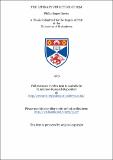The literary structure of 1QM
Abstract
Previous research on the Qumran scrolls, and in particular, IQM, has only recently involved the use of the most stringent literary - and form - critical techniques. These are of great value to Qumran studies; the history of the sect and its ideas can be learnt only when the texts are properly understood. IQM has been recognised by most scholars as a composite work, and XV-XIX has long been regarded as a unit. To this must be added II-IX which also comprises a single document. Both these documents are themselves composite. II-IX is a war-rule written in the Hasmonean period, and drawing on sources which originated in the Maccabean and immediate post Maccabean period. XV-XIX is a dualistic war-rule, which has developed from an earlier non-dualistic rule, of which col. XIV, 2-16a represents a small fragment. Cols. X-XII consist of a collection of liturgical pieces which have been found to reflect a Maccabean context in many cases. Col. XIII represent a fragment of liturgy probably associated with a covenant ceremony. Cols. II-IX, X-XII, XIII, XIV, and XV-XIX were collected and probably copied together; XV, 4-6a seems to refer to two documents which were independent at the time of writing, but have subsequently been incorporated into IQM - these are identified as II-IX and X-XII. XIII and XIV existed as fragments when they were brought together with the rest of the material from cols. II-IX, X-XII and XV-XIX. XV-XIX probably attained its present form in the second half of the first century B.C. In the first half of the first century A.D. a compiler produced from the collected documents a war-rule which included an introduction (col. I) written by the compiler. The final result is the War Scroll, the manuscript of which was written soon after the composition (= IQM). Its purpose is to prepare for the imminent war against the Romans.
Type
Thesis, PhD Doctor of Philosophy
Collections
Items in the St Andrews Research Repository are protected by copyright, with all rights reserved, unless otherwise indicated.

